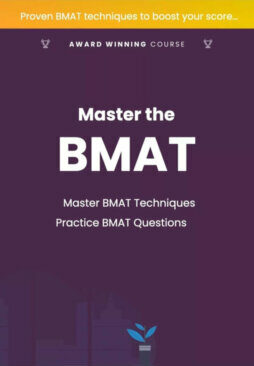UPDATE: Please note that CAAT have announced they will no longer be administering the BMAT in 2024, for 2025 entry. Cambridge University has announced that they will be using the UCAT as an admissions indicator. Oxford University are to announce admissions test changes in Spring 2024.
What is the structure of BMAT Section 2?
BMAT Section 2 tests applicants’ scientific comprehension, while Section 1 is designed to evaluate more of the general abilities a medical student might need to use.
Similar to Section 1, it is a multiple-choice test (with five to eight options per question). The only difference is that Section 2 requires slightly more time than Section 1. You will have 30 minutes to answer 27 questions. There will be exactly seven questions on maths, six on biology, and seven each on chemistry and physics. These exact numbers were recently introduced. You will notice when looking at past papers that the number of questions on each subject used to vary a bit from year to year.
What topics will I need to revise for BMAT Section 2?
The fact that the questions only require knowledge of each topic at the GCSE level is excellent news if you are one of the many applicants who did not study all three sciences at the A-Level. Going over your GCSE (or similar) notes in detail should be sufficient to cover most of the bases.
However, do take note when going through your GCSE notes that the BMAT Section 2 content specification does not fully align with the GCSE curriculum. This means that during your revision, you should still go through the BMAT Section 2 content specification to ensure that you have filled any gaps in knowledge.
The following list includes all the precise subjects you must study for each segment on the BMAT:
Biology
- Cells
- Movement across membranes
- Cell division and sex determination
- Inheritance
- DNA
- Gene technologies
- Variation
- Enzymes
- Animal physiology
- Ecosystems
Chemistry
- Atomic structure
- The periodic table
- Chemical reactions and equations
- Quantitative chemistry
- Redox reactions
- Bonding and structure
- Group chemistry
- Separation techniques
- Acids, bases and salts
- Rates of reactions
- Energetics
- Electrolysis
- Organ chemistry
- Metals
- Kinetic and particle theory
- Chemical tests
- Air and water
Maths
- Units
- Numbers
- Ratios and proportions
- Algebra
- Geometry
- Statistics
- Probability
Physics
- Electricity
- Magnetism
- Mechanics
- Thermal physics
- Matter
- Waves
- Radioactivity
Additionally, you must be familiar with the SI prefixes listed below because they might be used in any of the BMAT Section 2 topics:
| Prefix name | Value |
| Nano- | 10-9 |
| Micro- | 10-6 |
| Milli- | 10-3 |
| Centi- | 10-2 |
| Deci- | 10-1 |
| Kilo- | 103 |
| Mega- | 106 |
| Giga- | 109 |
What should I study for BMAT Section 2?
Acing the BMAT Section 2
Our online resources include hundreds of specifically crafted practice questions as well as past papers dating back more than fifteen years. You may use these to gain a sense of the question types, the test’s timeframe, and the amount of knowledge needed. Please take note that the format has changed several times in the past. This means that certain questions may no longer be applicable to the current syllabus, but they would provide good practice nevertheless.
Just as you would if you were retaking your GCSEs, you will need to devote time to studying all four topics; maths, biology, chemistry, and physics. Most of it should be quite simple once you start revising– the content should come back to you quite naturally! However, Physics continues to be a major source of worry for aspiring doctors as most students tend to favour Biology. The most effective use of your time is to focus on the topics that show up the most frequently. Keep in mind that only about a quarter of the questions will be on physics.
Lastly, review your mental and written maths skills. You will not have access to a calculator in the exam, so do not waste your time using one when you take the practice exams. On test day, being quick with fractions, percentages, and sums will also be beneficial.
How is Section 2 of the BMAT scored?
Each question in BMAT Section 2 is worth one mark and there is no negative marking, just like in BMAT Section 1. Your overall score is then calculated, with 1 being the lowest score and 9 the highest. According to our observations, the typical BMAT Section 2 score hovers around 5.0 or around 50%. Only 10% of applicants earn a score of 6.0 or higher. However, you may answer a few questions incorrectly and still score a perfect 9.0! This is because the marks of all the applicants over the world are collated and the 1.0- 9.0 score that you receive is based on a relative scale.

Our top tips for BMAT Section 2
The time pressure is definitely the most significant hurdle when attempting Section 2 of the BMAT, as it has 27 questions that must be completed in 30 minutes. Other than learning the content and science that would actually be tested, here are 10 suggestions that can improve your test strategy and enable you to get the most out of your study time.
1. Put time markers down.
Every 10 minutes, on average, nine questions must be answered. The response sheet is set out in three equal columns, so mentally dividing the section into thirds in this manner is quite helpful. To avoid falling behind, keep a written note of the time each part begins.
2. Do practice papers under time constraints
Try a couple of past papers in full under timed conditions alongside more extensive BMAT preparation such as doing other practice questions. It is highly recommended for you to be highly alert of your timing in order to ensure you are able to finish the exam in time. Keep in mind that you can always review the practice papers again when you are done, so it would be good to focus on finishing the test instead of being stuck on one or two questions.
3. Fill out your workings on the test paper.
For the BMAT, there isn’t any additional paper offered. Therefore, when you are practising, do not give yourself any room to work outside of the question paper. Make it a habit to write down just enough information that would allow you to maintain your train of thought, but not so much that it would take up too much space or too much of your time. This means that whole sentences are unnecessary and should be avoided!
4. Elimination could be faster than finding the exact solution
This is a textbook strategy for a multiple-choice exam. You can locate the correct answer more quickly by crossing off the answers that are definitely incorrect. Eliminating your options will also increase your chances of making a good guess if you are running out of time and need to answer the questions quickly. This method is especially effective for questions that require you to distinguish combinations of true and false propositions.
5. Fill in your answers as you are doing them
Write your response directly onto the response page once you have answered the question. Even if you are unsure of your answer, choose the most probable answer and fill it into your answer sheet. Waiting till the end to accomplish this wastes time because it necessitates reading the whole document again. Even worse, you might not have the opportunity to fill up your answer sheet if you are short on time.
6. Avoid over-skipping questions
It is best to skip the occasional question that you find challenging. However, be careful not to overdo it because it will make your time markers inaccurate. Additionally, if you suddenly feel as though you are unable to handle any of them, it may cause you to panic. Holding your composure and focusing on a question that appears challenging at first glance will usually result in the right answer and increase your confidence.
7. Record any missed questions.
The time lost looking for the questions you’ve missed out on is one of the issues with skipping questions. You may easily discover the questions you missed by keeping track of how many you skipped by writing down their numbers at the front or back of the exam paper. Furthermore, keeping track of your missed questions is important because you might forget that you have skipped them, and put the answer for the next question as the skipped question’s answer in your answer booklet. Take note of these details to avoid small mistakes that could be costly.
8. After answering a question, immediately move on to the next one.
Many qualified applicants squander time on questions they already know the answers to and have already answered correctly. This is because when you are under pressure, it may be reassuring to you to check your answer and to go over these questions again. Although this might help in assuring you that you have answered them correctly, this could actually be more costly as it takes up valuable time that you need to answer the remaining questions. Hence, you should be concentrating on answering questions that you haven’t yet figured out.
9. Work on your mental maths skills
In the long-term, improving your mental maths and pen-and-paper skills is an excellent approach to improving your Section 2 score. There is no better resource for developing these skills than the BMAT past papers, especially as you need to work comfortably with sums, powers, fractions, percentages, and decimals without a calculator in these papers.
10. Wear a watch for your examination!
On the day of the exam, do not assume that you will be able to see the clock clearly. If you do not know how much time you have left, it will be difficult to stay on track with your time markers and to know when to make intelligent guesses in place of missing information. However, do note that smart watches would not be allowed in the exam – try and bring analogue watches!



